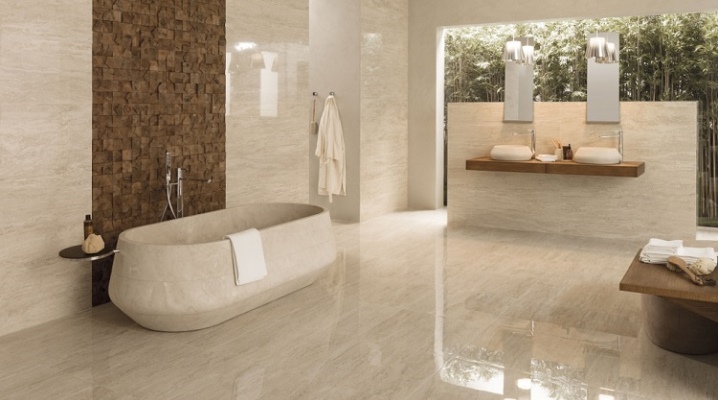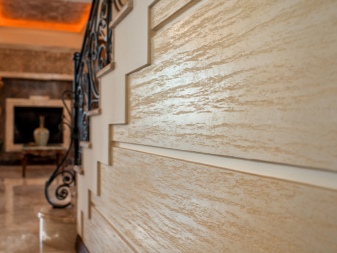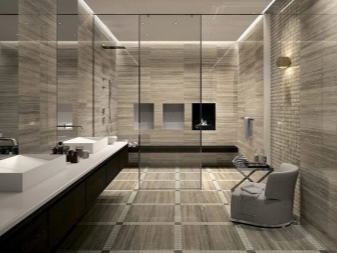What is travertine and where is it used?

Today, decorating the facades of houses and some interior elements with decorative stone is becoming more and more popular. Many people prefer to use artificial counterparts that look as natural as natural material, but they are inferior in strength. The best option for solving the issue of decoration is the use of travertine.
This stone looks spectacular, has served its owners for many decades, while its cost cannot be called high. And in the modern building materials market, it is not difficult to choose a suitable color palette of stone. Thus, everyone will be able to implement the preferred design idea of the design.


What it is?
Travertine is a building material that has come down to modern times from the distant past. The ancient Romans are considered the discoverers. They decorated the facades of buildings and structures with travertine. They stopped using it only when they studied the technology of laying clay fired bricks. Travertine is a member of the tuff family. In terms of characteristics and physical properties, it is similar to limestone rocks. Travertine chunks are easy to process due to their porous backing and low density. The same parameters explain the small mass of individual slabs.
In the construction environment, travertine is very popular, as it has many undeniable advantages. Initially, it is external beauty. Its attractive unobtrusive color and unpretentious drawing allow you to create design masterpieces of architecture. The unique properties of the presented stone make it possible to use it for interior decoration of premises and exterior decoration of facades.
Another important advantage is the low cost of the material.


The undoubted advantage of travertine is environmental friendliness from nature. This stone contains no radioactive substances that negatively affect the environment. Builders, in turn, note that it is very convenient to work with travertine. The stone itself is picky, easy to process. If necessary, travertine can be crystallized, thereby increasing its hardness.
And yet, along with the advantages, travertine has some disadvantages. And first of all, this is the need for additional care. In the home interior, this issue practically does not cause problems.


It is much more difficult to care for travertine on the facade of buildings. In this case, in no case should you use abrasive detergents that are located in the household drawer of every house. They can cause irreparable harm to the external beauty of the stone. To prevent this from happening, it is recommended to cover it with a protective mixture immediately after laying this material, which increases its resistance to chemical attack.
It should be noted that travertine is used to decorate not only individual elements of the interior. This stone is often used as a hall floor covering. However, in such a situation, the owner of the house must be prepared in advance that the floor will very quickly lose its attractiveness, since it will be constantly walked on both in slippers and in street shoes.


Where is it mined?
The origin of travertine occurs in the aquatic environment at a close distance from the coast and where there is an active current. Travertine is mined near Pyatigorsk. There are large deposits of this tuff in Armenia, Azerbaijan and Tajikistan. Huge deposits of travertine stone are located on the Italian and Turkish lands.
Despite such a wide variety of mining countries, the Iranian, Armenian and Kyrgyz varieties are in great demand in the construction environment.


Views
It is almost impossible to find untreated travertine on the market. However, facades and decorative elements trimmed with natural travertine look more advantageous if the material has been subjected to mechanical stress. There are several types of travertine surface depending on the processing method.
- Polished. A distinctive feature of this type of material is the specularly reflective shine and pronounced texture of the stone.

- Glossy. Another name is semi-polished. In this case, the stone has a smooth texture, but there is no intense shine. Visually polished travertine resembles satin. And with tactile contact, it is similar to a plastered surface.

- Sanded. This surface of the stone has some roughness. There is a small deep relief.

- Sawed. This type of processed stone has a more pronounced relief and a very noticeable roughness. The depth of the differences between the grooves is no more than 2 mm.

- Bush hammered. This type of stone is intended for facade decoration. Its distinguishing feature is its rough relief with a maximum drop of 5 mm.

- Brushed. When creating this type of stone, special brushes are used, which artificially age the slabs and give them intense roughness.

For indoor decoration, it is best to choose polished, glossy and sanded types of stone tiles. They are distinguished by a more or less smooth surface and a pleasant texture. But for the decoration of yard paving stones, it is preferable to use sawn travertine. Each travertine slab, after passing through a special treatment, is coated with polymer compounds, emulsion or mastic, so that the material gains additional strength and resistance to chemicals.
Today, decorative travertine is in great demand. Even the clay bricks used to lift structures have receded slightly into the background. That is why manufacturers began to put on sale not only natural stone, but also its artificial counterpart.


Natural
This type of travertine is presented on the market in the form of slabs and blocks of large sizes and shapes. This is not to say that their cost is very high, however, in comparison with an artificial analogue, it is quite tangible.


Artificial
Artificial travertine is not a stone, but the widely used "travertine", decorative plaster and travertine slurry. These materials contain a mixture of travertine dust and binders, cement, polymers and resins.
The undoubted advantages of an artificial analogue of travertine are low cost and the ability to change color, while maintaining a natural texture.

Processing methods
Travertine is a material that makes it possible to translate into reality the most unthinkable ideas of designers in terms of decorating various surfaces. A wide color palette, a variety of patterns and different types of processing of the same stone on different decorative elements will look different. In addition, the appearance of the stones varies from its location on the machine. The cross cut will reveal an unusual pattern that resembles cloud streaks. Ripping will create an interesting wavy line pattern.
Further, it is proposed to get acquainted with the methods of processing travertine, thanks to which the stone acquires an unusual texture.
- Aging. This processing method is divided into 2 types: mechanical and chemical. For mechanical, diamond-coated brushes are used. With their help, the surface of the stone is scraped, thereby creating a relief. The chemical method involves the application of acid to the material, due to which the stone is destroyed and irregularities remain on its surface. After this treatment, the stone is washed with soapy water, thereby stopping the oxidation process.
- Polishing. This method of processing is done using powder abrasives. After that, the travertine is rubbed with felt circles so that a mirror shine forms on the surface. To enhance the effect, it is proposed to use chemical agents. But first, it is necessary to fill the pores of the stone with a special mixture so that the acid does not get inside. Polished travertine can be used to decorate countertops or wall panels.
- Grinding. This method of processing is done on special machines, due to which the stone acquires a rough texture and dullness, but a pronounced pattern is preserved at the same time. Thanks to this method of processing, travertine loses its slippery properties, therefore, it can be used to finish the floor and steps.
- Sawing. For this method of processing, rope, band or circular saws are used.
- The use of a water repellent. This processing technology reduces the absorbency of the stone, which prevents stains on the face side. Travertine, impregnated with a water repellent, is used for decorating building facades.


Colors
On sale most often it is possible to find travertine of white, gray, yellow, beige colors. White travertine does not undergo polishing, so it brings with it warmth and comfort, incomparable with polished white marble. The classic variety of travertine is similar to the yellow Veronese marble. In addition to subtle delicate shades, travertine in dark tones can be found on sale. In this case, we are talking about red, pink, green, brown, black and gray. Such a bright palette is created by Iranian producers. And in order for them to look beneficial in combination with each other, the delicate taste of an interior designer is needed.
By the way, light shades of travertine can look good when combined with other materials. For example, a stone base is very often complemented by decorative plaster of a similar shade.



Application
Surely many people know that most of the historical buildings that have survived to this day were made of travertine or this stone was used as a decorative design. Today it is often used as a panel for the exterior of government buildings and cultural institutions. Thanks to the special treatment of the stone surface, such a facade will be able to serve faithfully for the city for more than one hundred years. Despite the porosity of the material, the protective layer does not allow moisture to seep into the stone and spoil it.
Today travertine is an integral part of the decoration of streets, parks and squares. Most landscape designers give their preference to this particular material. Thanks to the rough surface of the stone, there is a feeling of antiquity, and the aging effect is ideal for creating arches, tall columns and steps. The owners of cottages also preferred travertine, as this material looks rich and effective. This slab can decorate the facades of houses for many years.


Today, in the design of bathrooms, travertine is used instead of tiles. And some even trim the inside of the pool with it. If you follow the installation rules with travertine, it will be possible to decorate the interior walls of rooms with high humidity. - the feeling that you are in a Roman resort will be created. Inside the house, the entrance hall, corridor and living room are trimmed with travertine. This material fills the room with a special aura, comfort, while emphasizing the showiness and high cost of the interior.
Quite often travertine slabs are found in kitchen areas. This room is the heart of a house or apartment. She should exude comfort and warmth. The natural family environment is transformed if the travertine inserts are succinctly combined with the overall interior of the kitchen. The stone apron of the working area, the sink, the window sill look very interesting. By the way, craftsmen make elegant accessories from travertine that can be used in the bathroom, in the kitchen, in the living room and even in the bedroom. Miniature figurines or small impromptu paintings will add a pleasant touch to the atmosphere.



A wide variety of types of travertine allows you to create the most unusual interior design options not only in the house, but also in public places. For example, a bar counter in a nightclub with a mirror finish not only looks impressive, but also emphasizes the high status of the institution. The same can be said about the reception desk in the offices of large companies. Business center owners use travertine stone in the design of steps and entire staircases. According to the general design of the structure, you can make a cornice of travertine, a basement. The same stone can be used instead of paving slabs and decorated with curbs.
Lovers of vintage and old classics order travertine products from the craftsmen, which can be placed in any convenient place, for example, a fireplace or a mobile bar.


How to care?
Travertine stone can retain its attractiveness for many years if you provide it with proper care. But this does not mean that its surface can be washed with ordinary detergents. First of all, the owner of a travertine base needs to understand what kind of stone it is, its characteristics and features. Travertine refers to a limestone rock, therefore, it is very sensitive to aggressive environments. That is why it is required to use neutral detergents to wash its surface.
To increase the level of resistance of travertine slabs, after installation, their face is covered with a protective substance that clogs open pores. The owner of a travertine floor must understand that the protective mixture will wear off over time. Accordingly, abrasive substances of detergents will enter the stone through the pores and destroy the tiles. For this reason, it is not recommended to lay out the floor covering with travertine. It is important to take this fact into account for the owners of business centers and office premises, who, wishing to emphasize the status of the company, lay out the walls, floor and ceiling with travertine blocks.


If suddenly the travertine stone is damaged in the form of scratches or small cracks, it can be restored. But for this work it is necessary to call a specialist. In no case should you try to restore the appearance of travertine with your own hands. The foreman will come with the necessary tools, will sand the damaged areas, restore the potholes, fill in the irregularities with polymer mixtures in the appropriate color palette.
If necessary, the durability of floor travertine can be increased by coating it with a crystallizing chemical. After this procedure, the stone will slightly change, but its hardness will improve.
If you adhere to the described rules of care, travertine will delight with its beauty and attractiveness for more than one hundred years.


In the next video, you will see the travertine slab production process.













The comment was sent successfully.